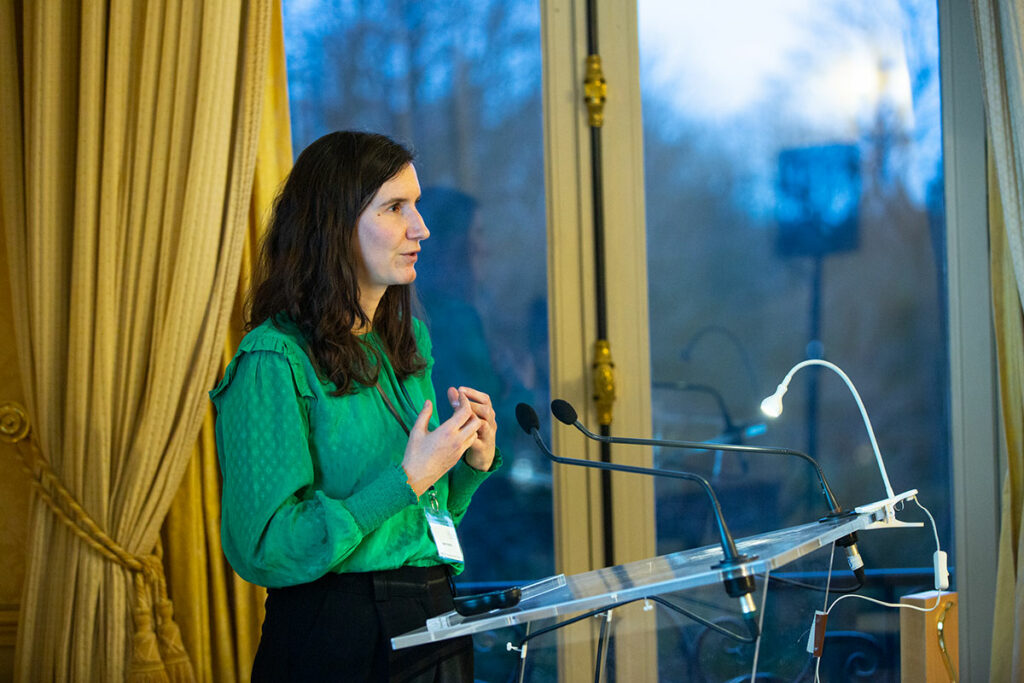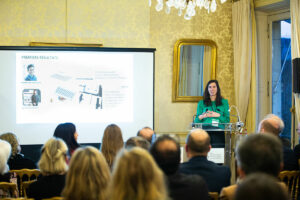
Dr Agathe Figarol — 3D Glimpse Project
Winner of the DVES 2023 Prize - Innovation category
SES108 — March 2023Doctor in nano-toxicology, teacher in biomedical engineering, and CNRS researcher within the BioMicroDevices team at the FEMTO ST Institute of the University of Franche-Comté, Agathe Figarol presents her 3D Glimpse project to combat glioblastoma.

Pro Anima Committee : The Pro Anima Scientific Committee and the Descroix-Vernier Foundation were absolutely delighted to award you the 2023 Descroix-Vernier EthicScience Prize in the Jury Prize category for your project “3D Glimpse. A tumor-on-a-chip to fight glioblastoma.
Could you present in a few words, for our readers, your project, its particularities, the objectives and results (in terms of and/or application) that you expect and within what time frame ?
Agathe Figarol : Thank you again for this recognition, it supports this 3D Glimpse project, which aims to develop a model in the human brain tumor laboratory. The objective is to be able to better study glioblastoma, the most common and aggressive brain cancer, but also to test new therapeutic approaches to combat it.
The technology used is organ-on-a-chip. This combines tissue engineering to reproduce human tissue (here that of glioblastoma) and microtechniques for the manufacture of the microchip, and its micro-channels in which a biological fluid is perfused to reproduce blood circulation. It is therefore a very multidisciplinary project.
Several tumor-on-chip prototypes will emerge, of increasing complexity, on time scales varying from a year and a half, 3 or even 5 years. First of all, a healthy tissue with the particularity of reproducing different sizes of blood vessels : Venules and capillaries, with their very particular organization within the brain : 3 types of cells (endothelial, astrocytes, pericytes), which overlap to form the barrier hemato-encephalic (between the blood and the brain). Secondly, cancer cells will be added to reproduce the glioblastoma and its vascularization. Thirdly, the microchip will be equipped with “bio” sensors to detect the transport and effectiveness of new drugs. The questions this chip will answer are for example : is this new nano-drug capable of passing the blood-brain barrier ? Is it effective in destroying cancer cells ? What are its impacts on surrounding healthy cells ? Can we predict its toxicity and the side effects it will cause ? In order to go further into the possible responses, the microchip can continue to be optimized by adding cell types (such as cells of the immune system), or by associating it with other organs-on-chip (for example the intestine, to study the link with the microbiota). Lots of ideas for the years to come !
PA : What phase of your research the Prize will boost ?
AF : The 3D Glimpse project has only just started a year ago. Of course, it is the result of prior explorations, notably during my postdoctoral work at Osaka University, where I worked on the reproduction of a network of cerebral blood capillaries within a gel. But it is since I joined the FEMTO-ST Institute in Besançon, and a team specializing in microsystems for health, that it has really taken off. Having a long-term position as a teacher-researcher also allowed me to plan for the longer term, and to respond to calls for projects such as the Descroix-Vernier EthicScience prize. Student projects with ISIFC, the biomedical engineering school where I teach, have helped explore the subject. A Master’s student joined me at the beginning of the month for a first long internship and a real start of the experiments.

PA : The determining condition of the Descroix-Vernier EthicScience Prize is to promote and reward programs that use or develop non-animal models. What were your motivations, the reasons that have pushed you to work using those methods and towards the replacement of animal experimentation ?
AF : In addition to the primordial ethical question, there is also a scientific question. What interests me is understanding living things. Animal experimentation is like a “black box” in which we do not really know what parameters come into play. In addition, the results are not always reliable, since they are far from humans. Today, however, animal testing still seems difficult to avoid, particularly for testing new drugs. There is therefore a clear need to develop alternative models and to prove their reliability and their physiological relevance so that they can support medical research.
PA : Have you had to, at any point in your career, experiment on animals ? If so, what difficulties or failures have you encountered ?
AF : During a postdoctoral fellowship in Toulouse, to prove the validity of in vitro models (cells on membrane to represent the walls of blood vessels, and spheroids to represent tumors), I had to call on a colleague to carry out preliminary tests on tumor-bearing mice. These were control mice from another study, which allowed us to limit the use of animals. This goes back a few years already when in vivo experimentation was almost systematically requested by scientific journals. Mentalities are changing little by little.
PA : In which research context (French, European, international) does your program fit ? What are the challenges of your project ?
AF : The 3D Glimpse project received local aid via the University of Franche-Comté, and regional aid throughout Burgundy-Franche-Comté, before receiving this Descroix-Vernier EthicScience prize granting it recognition at the national scale. If the project is indeed part of an environment of local partners, it is resolutely international, on the one hand via collaborations with Japanese universities and companies, but also via its public health and ethical issues. Brain cancer actually represents 2% of all cancers, or the equivalent of 7.7 million “lost” years (because of illness, resulting disabilities, or early death). It is the 2nd cause of cancer in children, after blood cancers. Finding new therapeutic approaches would therefore have major repercussions on a global level. Furthermore, by tackling one of the challenges in the field of tissue engineering : vascularization, the 3D Glimpse project could be a basis for the development of other models of human tissues on microchips, and participate in the development of alternatives to animal testing.




